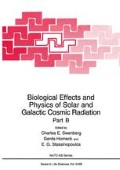Abstract
The Sun is responsible for many of the phenomena on Earth, including the maintenance of life. In addition, magnetic storms, capable of disrupting radio communication, and auroral displays are associated with solar events. Man-made electrical, satellite, and communication systems are affected strongly by the near-Earth space environments. The purpose of this paper is to review briefly the interaction of solar activity with the near-Earth environment. These processes can be studied by examining two sets of interactions. That is, the interaction of the solar electromagnetic output with the Earth’s neutral atmosphere, and the solar corpuscular output with the geomagnetic field. In order to understand the types of interactions one needs to know more details of the interacting components. Therefore, the near-Earth environments which comprise neutral atmospheric, ionospheric and magnetospheric regions will be discussed in relation to the direct and indirect influences of solar activity.
Access this chapter
Tax calculation will be finalised at checkout
Purchases are for personal use only
Preview
Unable to display preview. Download preview PDF.
References
Akasofu, S.-I., 1981, Energy coupling between the solar wind and the magnetosphere, Space Science Reviews, 20: 121.
Altrock, R.C., Neidig, D.F., DeMastus, H.I., Radick, R.R., Evans, J.W., Simon, G.W. and Keil, S.I., 1985, The Sun, in: “Handbook of Geophysics and the Space Environment”, A.S. Jursa ed., National Technical Information Servic, Spring field, VA, U.S.A.
Bame, S.J., Asbridge, J.R., Feldman, W.C. and Gosling J.T., 1976, Solar cycle evolution of high speed solar wind streams, Astrophys. J., 207: 977.
Brinton, H.C., Grebowsky J.M. and Brace, L.H., 1978, J. Geophys, Res., 83: 4767.
Crooker, N.U. and Siscoe, G.L., 1986, the effect of the solar wind on the terrestrial environment, in: “Physics of the Sun”, vol.3, P.A. Sturrock, ed., D. Reidel, Hingham, Mass.
Dryer, M, 1987, Solar Wind and Heliosphere, in: “The Solar Wind and the Earth”, S.-I. Akasofu and Y. Kamide, eds., Terra Scientific Publishing Company, Tokyo.
Ely, J.T.A., 1984, “Cosmic Rays, Solar Activity, Magnetic Coupling, and Lightning Incidence, 1984”, NASA Contractor Report 3812, NASA.
Feldstein, Y.T., and Starkov, G.V., 1967, Dynamics of auroral belt and polar geomagnetic distrubances, Planet Space. Sci., 15: 209.
Feynman, J., Gu, Y.Y., 1986, Prediction of geomagnetic activity on time scales of one to ten years, Rev. Geophys., 24: 650.
Gorney, D.J., 1990, Solar-cycle effects on the near-Earth space environment, Rev. Geophys., 28.: 315.
Haerendel, G. and Paschmann, G., 1982, Interaction of the solar wind with the dayside magnetosphere, in: “Magnetospheric Plasma Physics”, A. Nishida, ed., D. Reidel Publishing Co., Dordrecht. Boston. London.
Hapgood, M.A., Lockwood, M., Bowe G.A., Willis, D.M. and Tulunay Y.K., 1991, Variability of the interplanetary medium at 1 a.u. over 24 years 1963’1986, Planet Space Sci., 39: 411.
Heikkila, W.J., 1990, Magnetic reconnection, merging, and viscous interaction in the magnetosphere, Space Science Reviews, 53: 1.
Heppner, J.P, 1977, Empirical models of high latitude electric fields, J. Geophys. Res., 82: 1115.
Hones, Jr., E.W., 1986, the Earth’s magnetotail, Scientific American(march): 32.
Lockwood, M. and Fuller-Rowell T.J., 1987 a, Geophys. Res. Lett. 14: 371.
Lockwood, M. and Fuller-Rowell T.J., 1987 b, Geophys. Res. Lett. 14: 581.
Neugebauer, M., 1991, The Quasi-stationary and transient states of the solar wind, Science, 252: 405.
Nishida, A., 1982, Origin of magnetospheric plasma, in: “Magnetospheric Plasma Physics”, A. Nishida, ed., D. Reidel Publishing Co., Dordrecht. Boston. London.
Ratcllife, J.A., 1970 “Sun, Earth and Radio” world University Library, Weidenfeld and Nicolson, London.
Richmond, A.D., 1987, The ionosphere, in: ‘The Solar Wind and the Earth,” S-I. Akasofu and Y. Kamide, eds., Terra Scientific Publishing Company, Tokyo.
Rodger, A.S., 1990, Recent progress In understanding the magnetospheric environment: in “Solar-Terrestrial Predictions: Proceedings of a Workshop at Leura, Australia, October 16-20, 1989”, National, Oceanic Boulder, Colorado, U.S.A. and Atmospheric Administration Environmental Research Lab. Boulder, Colorado, U.S.A.
Russell, C.T., 1987, The Magnetosphere, in: “The Solar Wind and the Earth”, S.-I. Akasofu and Y. Kamide, eds., Terra Scientific Publishing Company, Tokyo.
Schwenn, R., 1990, What does the solar wind tell the prediction community?, in: “Solar-Terrestrial Predictions: Proceedings of a Workshop at Leura, Australia, October 16-20, 1989”, National Oceanic and Atmospheric Administration Environmental Research Lab. Boulder, Colorado U.S.A.
Taylor, H.A. and Tulunay, Y.K., 1973, Near-simultaneous measurements of the plasma trough and plasmatail from OGO-4 and Ariel-3, Proc. Chapman memorial Symposium June 18-22, Boulder, USA.
Tulunay, Y.T., Willis, D.M., Hapgood, M.A. and Lockwood, M., 1991, Influence of the interplanetary medium on mid-latitude ionospheric variability,”Final Report”, NATO Collaborative Research Project, NATO, 0753/87.
Tulunay, Y.K. and Grebowsky, J.M., 1987, Hemispheric differences in the morphology of the high latitude ionosphere measured at ~ 550 km, Planet. Space Sci., 35: 821.
Visentine, J.T. (Ed.), 1988, “Atomic Oxygen effects measurements for shuttle missions STS-8 and 41-G”, NASA Tech. Memo., TM-100459, I-III.
Walterscheid, R.L., 1989, Solar cycle effects on the upper atmosphere: Implication for satellite drag, J. Spacecr. Rockets, 26: 439.
Author information
Authors and Affiliations
Editor information
Editors and Affiliations
Rights and permissions
Copyright information
© 1993 Springer Science+Business Media New York
About this chapter
Cite this chapter
Tulunay, Y. (1993). Solar Energy and its Interaction with Earth’s Atmosphere. In: Swenberg, C.E., Horneck, G., Stassinopoulos, E.G. (eds) Biological Effects and Physics of Solar and Galactic Cosmic Radiation. NATO ASI Series, vol 243B. Springer, Boston, MA. https://doi.org/10.1007/978-1-4615-2916-3_7
Download citation
DOI: https://doi.org/10.1007/978-1-4615-2916-3_7
Publisher Name: Springer, Boston, MA
Print ISBN: 978-1-4613-6265-4
Online ISBN: 978-1-4615-2916-3
eBook Packages: Springer Book Archive

